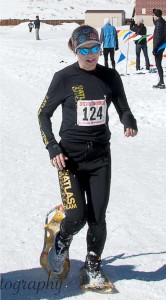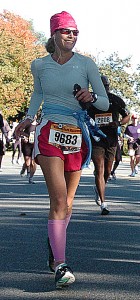 Editor’s Letter
Editor’s Letter
One of the things I love about producing this magazine is that I learn so much. The snowshoe community, while small, is literally bursting at the seams and wanting to grow into something big. The whole concept of recreational and competitive snowshoeing is not as popular here as it is in Europe; but those of us who live in states that get any sort of consistent snow each winter are soon going to see what a great sport snowshoeing is.
I’m happy to report that I now have my own pair of snowshoes and cannot wait to try them out. Perhaps while my sons hit the slopes this winter, I’ll attempt a jaunt on my new snowshoes.
I’ll admit that when I hear the word “snowshoe,” I picture the big wooden tennis racquet-looking contraptions people used to strap to their feet. As you’ll learn in this issue, snowshoes and snowshoe technology has come a long way.
The best thing I can tell you is that the three main snowshoe manufacturers featured throughout this issue – Kahtoola, Northern Lites and RedFeather – all are American companies manufacturing and selling American-made products. The athletes featured or mentioned in this issue love these brands. Some, like Lisa Schrader of Colorado, use Northern Lites for recreational snowshoeing and RedFeather for racing. Others, such as Josiah Middaugh (featured on our cover) and Travis Macy, race for and with Northern Lites; and Jared Scott touts Kahtoola as his snowshoe of choice.
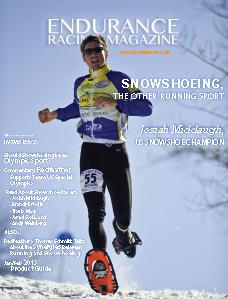 I interviewed a TON of people for this issue. It all started with Mark Elmore of the United States Snowshoe Association. His goal? To make snowshoeing an Olympic sport. After talking with all the athletes I did, all I can say is, Why not? The sport has appeal. It is the winter version of running, basically. People who compete in snowshoe races compete like a runner would. In essence, I have no problem supporting the cause and the growth of this phenomenal, low-impact, high-intensity sport which is easy to pick up, inexpensive in terms of equipment, and – according to the athletes I’ve spoken with – a lot of fun.
I interviewed a TON of people for this issue. It all started with Mark Elmore of the United States Snowshoe Association. His goal? To make snowshoeing an Olympic sport. After talking with all the athletes I did, all I can say is, Why not? The sport has appeal. It is the winter version of running, basically. People who compete in snowshoe races compete like a runner would. In essence, I have no problem supporting the cause and the growth of this phenomenal, low-impact, high-intensity sport which is easy to pick up, inexpensive in terms of equipment, and – according to the athletes I’ve spoken with – a lot of fun.
I hope to write about my experiences snowshoes soon – and what I really hope is that I’ll have a snowshoe race under my belt, as well.
Please take a look in the Product Guide or throughout the magazine for information on the snowshoe manufacturers. Enjoy the issue!
As usual, we’d love your feedback and comments. Feel free to email me at [email protected].
See the Digital Issue. Click here!
]]>If Mark Elmore had his way, the answer would be “Yes”. Elmore, the director of the United States Snowshoe Association (USSSA) is driven by his quest to add the sport to the list of events at the Winter Olympics – especially since there is a US Special Olympics Snowshoe Team, which happens to be competing at the 10th Special Olympics World Winter Games in PyeongChang and Gangneung, South Korea, from January 29 – February 5 this year.
“One day, the Olympic Committee will wake up and realize that snowshoe racing is the wave of the future,” said Thomas Schmitt, who manages marketing and public relations for Redfeather Snowshoes, a retailer out of Wisconsin.
The USSSA serves as the lead governing body for the sport of snowshoe racing in the US. As part of that mission, they promote the organizational growth of the sport in accordance with the International Amateur Snowshoe Racing Federation, of which Elmore is a member. Their goal is to achieve recognition by the US Olympic Committee in hopes of gaining status as an Olympic sport.
|
Countries with at least one Snowshoe Organization Andorra |
Curling Paid Its Dues and Became an Olympic Sport
The International Olympic Committee (IOC) has very specific rules and regulations governing decisions over whether a sport will be considered for inclusion in the Olympics. While some scratch their heads as to why a sport like curling was accepted into the Olympics back in 2006, the sport has had a global following since the 1800’s and has followed a series of steps toward acceptance by the IOC…and that acceptance took, if you map it out, many many years. The sport adopted a governing body back in 1838, but it wasn’t until 1957 that it formed an international organization – a requirement for consideration as an Olympic sport. In 1959, Scotland and Canada launched the Scotch Cup series, and other countries (including the US) joined. It wasn’t until 1965 when six countries – Scotland, Canada, USA, Sweden, Norway, and Switzerland – agreed to a proposal to form the International Curling Federation. In 1966, France joined the ICF, and a set of rules for international competition was proposed. Finally, after the ICF changed its name to the World Curling Federation (WCF) in 1982, the IOC in 1983 agreed to include Curling program of the SVIII Olympic Winter Games in 1988.
The WCF continued to develop its governing responsibilities and its Constitution and Management Structure, which included the election of an Executive Board. A formal headquarters was set up, and from there, other international events were born – including the first World Wheelchair Curling Championship in 2002.
Modern Snowshoe History Predates Curling
While the origin and age of snowshoes are not precisely known, it’s guessed they were used between 4,000 and 6,000 years ago. North American indigenous people developed snowshoes prior to the 20th century, and designs changed depending on geography. As European settlers came to the US and Canada, snowshoes were used by fur traders and even in war. In 1757 and 1758, two skirmishes during the French and Indian War (which started in 1754) were fought by British troops wearing snowshoes.
Skip to more modern times where Alaskan and other indigenous tribes participated in the Arctic Winter Games, an international biennial event which was founded in 1969. Starting in the 1950’s, however, snowshoes started to evolve into more of what you see today, morphing into athletic versions that are used by snowshoe athletes both recreational and professional.
Can Snowshoeing Build the Right Audience?
Despite the fact that 4,700 snowshoe enthusiasts converged on Val di Non, Italy, to celebrate the 40th anniversary of the world’s largest snowshoe race, the IOC doesn’t appear impressed. The International Snowshoeing Federation (ISF) boasts 18 countries worldwide and has a three-member board on which the USA, Japan, and Switzerland serve. Mark Elmore is the board member from the United States.
Why the IOC is lingering on adding snowshoeing as a sport is a bit of mystery, since there is a Special Olympics Snowshoe Team. Perhaps the IOC’s disinterest or unwillingness to add snowshoeing as Olympic sport has everything to do with the sport’s organizational inconsistency around the world. Even in the US, Elmore agrees that the organizational status of the USSSA has been both inconsistent and disorganized. Further, while it has been in existence since 1977, the association’s membership has not grown – despite an increase in snowshoe sales and enthusiasts. Headquartered in Corinth, N.Y., the association used to have a local/regional presence before it went national: about 30 years ago it became involved with the Empire State Winter Games. But though the USSSA may be recognized for spearheading interest in competition on the national level, the rules and manner with which the sport is managed from state to state does not follow a set standard.
“There are different races with race directors who are not following a standard set of racing rules,” Elmore said. “Therefore, there is no consistency or continuity with the sport around the nation.”
That inconsistency coupled with limited member benefits can account for the low numbers in membership at the USSSA. According to Wisconsin snowshoe competitor Kevin Tarras, who has competed at Nationals, “Many snowshoers will join the USSSA to compete in the Nationals, but after that, there is little incentive beyond that to maintain membership.”
Tarras and other snowshoers, like Colorado snowshoe athlete Lisa Schrader, say the sport is amazing and offers tons of exercise benefits. “It’s also free to snowshoe,” Schrader said. “That and the fact that the equipment is not expensive makes the sport very attractive.”
Schrader, who has introduced many of her friends to the activity, sees no reason why snowshoeing should not be an Olympic sport. And while others like Tarras agree, the lack of consistency in the sport creates an image of a game that doesn’t have it all together. And, because the IOC is very political and has its own set of standards, the inclusion of snowshoeing as a recognized Olympic sport could be difficult.
The Movement to Influence the IOC
Elmore realizes there is no silver bullet, but he hopes that there is some way to develop continuity in racing regulations. Resources, he mentioned, were an issue, as he and his staff work on a volunteer basis.
But if anyone can pull this together, Elmore can – for his determination, if not for his commitment and experience. In 2001, after being involved with the association for many years, Elmore was asked to be the director of the USSSA. They set a goal of coordinating a US Snowshoe program, with races across the country following common rules, regulations and race protocols. “I was involved with starting the national championship racing program,” he said.
To promote growth in the sport, the USSSA started the national championships (now on its 14th year). The championships will be held in Oregon in 2013. The championships used to be an open race, but now the competition involves coordinating 37 different events in 24 states, where athletes look to actually qualify for Nationals.
The word is getting out about snowshoeing. According to Elmore, the sport is gaining a foothold all over the US, even in states like North Carolina, New Mexico, and Arizona, where you would not expect snowshoeing to be popular.
Globally, the ISF would like to develop a new World Cup series, and stay in front of the IOC.
Looking for Membership
When it comes to the USSSA, Elmore wants to see a growth in membership – but the association needs to demonstrate its value. Aside from the requirement to belong to the association to compete on the national level, the association needs to provide other benefits to its members; and for a tiny association with no budget, that’s tough to do.
“Maybe people think we are much bigger than who we are. There are only four of us who manage the association. All of us are volunteers and don’t get paid a cent. Usually we end up paying money, actually. This is all for the passion of the sport; we are really a Mom-and-Pop organization,” Elmore explained.
Today there are only 500 members in the USSSA. The membership fees help the association participate and manage some races, but the reality is that membership offers little in the way of incentive. Members receive a patch or bin, a membership card, and a subscription to Trail Running Magazine (which covers snowshoeing, but not year-round).
Increasing Value and Joining Forces with Manufacturers
Kevin Tarras, who races in Redfeather snowshoes, loves the sport and would welcome a growth in the number of people who participate. He suggested that in working with local running stores, maybe the USSSA could give seminars on snowshoeing to generate interest.
While that is a good idea, another issue remains: snowshoes are not carried in running or cycling stores generally. Craig Brooks of Northern Lites said that their goal in 2013 is to get more of their product into stores. Currently, they partner with a few cycling stores who are willing to carry the snowshoes.
The USA Special Olympics Snowshoe Team, however, is alive and kicking.
Helping Hands from Sports Manufacturers
Flagstaff, Ariz., is the headquarters for snowshoe manufacturer Kahtoola. The company sponsors national championship competitor Jared Scott, who competed in the World Snowshoe Competition in Italy on January 6, 2013, placing 16th and top American.
]]>
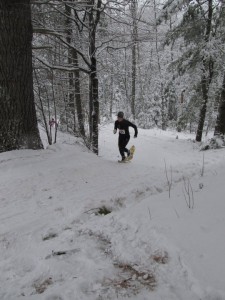 Brandy Erholtz, one of the top USA female snowshoe competitors, began snowshoeing as an adult. Her records around the country stand uncontested.
Brandy Erholtz, one of the top USA female snowshoe competitors, began snowshoeing as an adult. Her records around the country stand uncontested.
“You’d think I’d been snowshoeing since infancy; however, this wasn’t the case.”
– Brandy Erholtz
Brandy Erholtz grew up figure skating in International Falls, Minn. She started in first grade and skated all the way through school. When she was 12 years old and in the 7th grade, Erholtz started running cross country and track; but in International Falls, snow sports are just part of the atmosphere. After she got married and moved to Duluth, Erholtz bought her first pair of snowshoes.
“My husband and dogs and I would hike around the trails in Duluth any time there was fresh powder. At that point, the thought of racing on snowshoes had never crossed my mind. We moved to Colorado in 2006, and I was still only a snowshoe hiker,” she said.
But after a couple of years in the outdoor environs of Colorado’s mountains and trails, Erholtz began competing in mountain running races. In 2008, she qualified for her first U.S. Mountain Running team in what was an “uphill year.” (Mountain running alternates even/odd years: uphill-only on even years, up/down courses on odd years.)
“I had a blast representing the U.S. in Switzerland, and as soon as I finished the race set my goal to make the 2009 team. With 2009 being an up/down year, I knew I was going to have to work on my downhill running. I had met a few other trail/mountain runners who did a little snowshoe racing in the off season, so I decided to give it a go. Falling in the snow couldn’t hurt nearly as badly, and could potentially help me learn to run fast and stay relaxed on the downhill,” she said.
In the winter of 2009, Erholtz competed in only three snowshoe races, but learned of its value. While she got lost in two of the races, she surprised herself by winning the National Championships in Mt. Hood. During her running season that summer, she went on to qualify for her 2nd U.S. Mountain Running team. Erholtz attributed her success to the snowshoe racing: it was a good way to stay competitive in the winter, get a good workout and continue working on her downhill running.
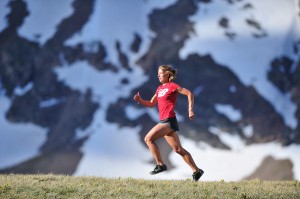 “I really love how snowshoeing prepared me for my running season. I’ve been on the Atlas Snowshoe Team the past three-plus years,” Erholtz said.
“I really love how snowshoeing prepared me for my running season. I’ve been on the Atlas Snowshoe Team the past three-plus years,” Erholtz said.
On Training
When it comes to training, Erholtz has been faithfully working with coach Gary Lepisto since the spring of 2005. Lepisto, who is from Duluth, is a trained Lydiard coach (see box).
“He has really helped me develop as a runner and reach a level I never dreamed was possible. We break my training into phases, using the Lydiard system as a guide. The past 5 years, my two primary goals each year have been first to make the mountain team and represent the U.S. at Worlds, the second being to ‘peak’ at Worlds. Each winter I build a huge aerobic base through long steady-state runs, and eventually incorporate tempo, speed, hills and tune-up races,” Erholtz said.
Erholtz does most of her running on the trails close to her home in Evergreen. Her favorite run this past year has been Bergen Peak.
“I love running uphill and exploring new places and new trails. I have a few training partners in town, but I tend to do a lot of my running by myself. I actually like the thinking and praying time it gives me. My dogs (Ches-E and Fischer) do quite a bit of my easy running with me as well. You can’t really ask for a more motivated training partner than one with a wagging tail, leash hanging out of its mouth,” she said.
Being a Brand Ambassador
Erholtz’s first pair of running shoes were New Balance, and she has been a loyal customer for the past 23 years. Four years ago, she became a New Balance Outdoor Ambassador, and has been fortunate enough to have had many opportunities with them in regards to racing and overseas travels
“I absolutely LOVE their shoes,” she said. “I am also thankful to New Balance for the small travel stipend, and to race directors who give comp entries and who sometimes help with lodging and/or travel expenses. Sometimes I’ll get lucky and win a little prize money, which negates the expenses it took to get there.”
Aside from New Balance, Erholtz just started working with the clothing manufacturer Injinji, and loves their socks. “I was skeptical about toe socks and still think my feet look silly while wearing them; however, they have alleviated the rubbing between the toes I used to get and are the most comfortable socks I have ever worn. I’d tell people, Don’t judge them until you try them!” she said.
Erholtz is also sponsored by PowerBar and uses their products while training, for recovery and snacks – in particular the double latte and raspberry crème gels, cola energy blasts and the chocolate peanut butter caramel recovery bar.
Running and snowshoeing have been great complimentary sports for Erholtz.
“I truly love to run; getting outside each day energizes me. I love running up and down mountains and exploring new trails. I am a Christian, and my runs are a really spiritual time for me. I spend a lot of time praying during my runs and also praising God for His gifts. I am also a competitive person, so on the rare days when I struggle to find motivation, I think of my competition and what they might be doing.
Erholtz and her husband have been married for 10 years. They have two dogs and four cats. Erholtz has worked as a special education teacher for about 12 years for Jeffco Public Schools. She is now a Prevention Liaison and teaching two adjunct classes. Further, in the past couple of years, she has taken on a lot of extra work with curriculum writing and course development. Erholtz is also an assistant cross-country coach at Evergreen High School.
Read more on Brandy at:
http://www.runningsnowshoes.net/2011-women-nationals/
http://www.snowshoemag.com/2012/10/23/catching-up-with-the-u-s-national-snowshoe-team/
]]>
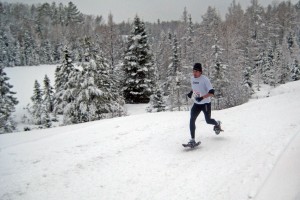 Jared Scott
Jared Scott
“Nothing’s slowing down yet, I’m only 30…although I probably couldn’t run a 4:08 mile like I did when I was 21; but when I was 21 I couldn’t do a race that was over 2 hours, so I guess that’s the tradeoff. A good old high school friend of mine, who is a cyclist, and I were joking around once about how as you age you get Old Man Power. The raw speed goes away as you age, but the power from doing this for years and years builds up and leads to incredible strength and endurance. It’s really a beautiful thing.”
- Jared Scott
Jared Scott, a member of the 2012 United States National Team, competed in the 2013 La Ciaspolada snowshoe race in the Val di Non of Northern Italy on Jan. 6, 2013.
Scott, who classifies himself as a mountain, trail and snowshoe racer, competes in the 10k distance for snowshoeing and other races. The 30-year-old who now lives in Colorado has been competing in endurance races for years, and has found much success as an internationally recognized snowshoe racer.
Scott started running when he was 13 and was successful throughout high school. He ran in Division 1 in college for a top cross country program, moved to Flagstaff for grad school and got hooked on trail running. He even went to the Grand Canyon, which is near his then-home in northern Arizona, and started running and training there.
“When I started running in the Grand Canyon, my first run was down to the Colorado River and back up (~5000 ft elevation change in ~7 miles each way). It took me a few hours to do, and I was so exhausted that I came home and slept for 4 hours.”
But it wasn’t long before Scott has the record for running the Grand Canyon Rim to Rim race from the North Rim to the South Rim in 2011. He tried again for the record in 2012 and his friend broke his record by 15 minutes. Another friend also broke his record as he came in 3rd this year.
The same winter he started running in the Grand Canyon, there was a lot of snowfall in Northern Arizona. That winter, Scott was lucky enough get in with the local snowshoe company Kahtoola and test some snowshoes for them. This was Scott’s first experience cross-training in snowshoes on trails with 5 feet of snow on them. His switch to competitive snowshoeing started in the winter of 2009-10, with great success.
ERM caught up with Scott to ask him about his snowshoeing experiences.
ERM: What are some of the differences you see between snowshoeing and regular ultra distance racing – other than the gear, of course?
Scott: It’s different, and it can be very tough because of the added weight and how much snow conditions can vary. Deep snow is really like running uphill. It can be highly anaerobic and it’s like running in slow motion. This is the typical snow you’ll encounter if you just go out in the woods and run. Groomed snow is extremely fast and is the kind of snow that many races have. There’s also hard-packed and icy, which is usually what you’ll encounter in the early mornings, and a lot of times you end up busting through the hard pack into soft powder. When snow warms up, it can be slushy and very wet and slow. There is also a thing called “sugar snow,” which happens when the snow blows; it’s tough to run in because it’s difficult to get traction in it. But I think the things that surprised me the most about snowshoe running is how much you actually can sink in the snow – I always thought I would float right on top – and that snowshoes are awesome for traction in the snow.
ERM: We’d also like to know a little about your training regimen.
Scott: I like to do a couple of tough workouts a week. I usually do one day of hill training; this is usually running up the steepest route I can find and doing it weekly to try to improve on my time. The other workouts I like to do are a fast 6-mile tempo run on a rolling course, and try to work down my times over the weeks. I also like to do at least one long run of around 1.5 to 2 and sometimes 3 hours during the week. The long run is probably the most consistent and most important workout I do. Hills are great when you need to get in shape in a hurry, and the tempos are good for feeling the grind of a race.
ERM: At this level, does anyone sponsor you for your snowshoe races?
Scott: Yes, Kahtoola Snowshoes and Inov-8 Shoes sponsor me.
ERM: Can you tell us a little about your work/life balance?
Scott: I’m married and have 3 dogs. I work full-time for the Bureau of Land Management as a GIS (computer mapping) Coordinator. To balance training with work, I like to run to and from work a couple of times a week, which is 5.5 miles one way. It kills two birds with one stone, because I get my training in while I commute.
ERM: What drives you and keeps you sustained during competition?
Scott: A lot of times it’s remembering while I’m racing to have a good time. It’s easy to get caught up in all the jitters and edginess of nervous runners on the starting line; but once I’m in the race and I’m on a beautiful trail climbing up some mountain, there’s really no other place I’d rather be. I love it.
ERM: Do you maintain a budget for racing and competition?
Scott: Yes, I budget, because racing is expensive. Also, I do try to win prize money to ‘support the habit’. It’s tough to win prize money because there are so many good racers out there, so I do budget and choose my races carefully. When I travel I don’t stay in expensive hotels. A lot of times I will share a hotel room with a friend or stay with a family willing to take in a racer, but many times I’ll just rent a car that has a back seat that folds flat so I can sleep in the back. I sometimes bring a one-person lightweight tent with me, too, so I can just camp. I found that the car and camping is sometimes the easiest thing to do, because I can just do my own thing the night before and then show up and run fast the next morning. But it’s really my day job that allows me to afford to travel to races.
ERM: Tell us something about you that we wouldn’t know.
Scott: I stopped running for a month once because I was burnt out, but then got gall stones because I stopped doing life-sustaining things like remembering to drink water (because I would never forget to drink water before I would go run). So after that painful experience, I started running again – and I also remember to drink water.
ERM: Have you had any injuries or lingering issues?
Scott: I have arthritis in my big toe, but as long as I’m doing some serious training, my toe usually feels fine. If I’m not running very much, the pain gets worse. I used to be plagued for years with Achilles problems and planter fasciatis, but changing my running shoes to flat flexible shoes and correcting my running form fixed those problems.
Read more at:
http://outdoors.campmor.com/snowshoe-racing-in-the-united-states-2012/
]]>